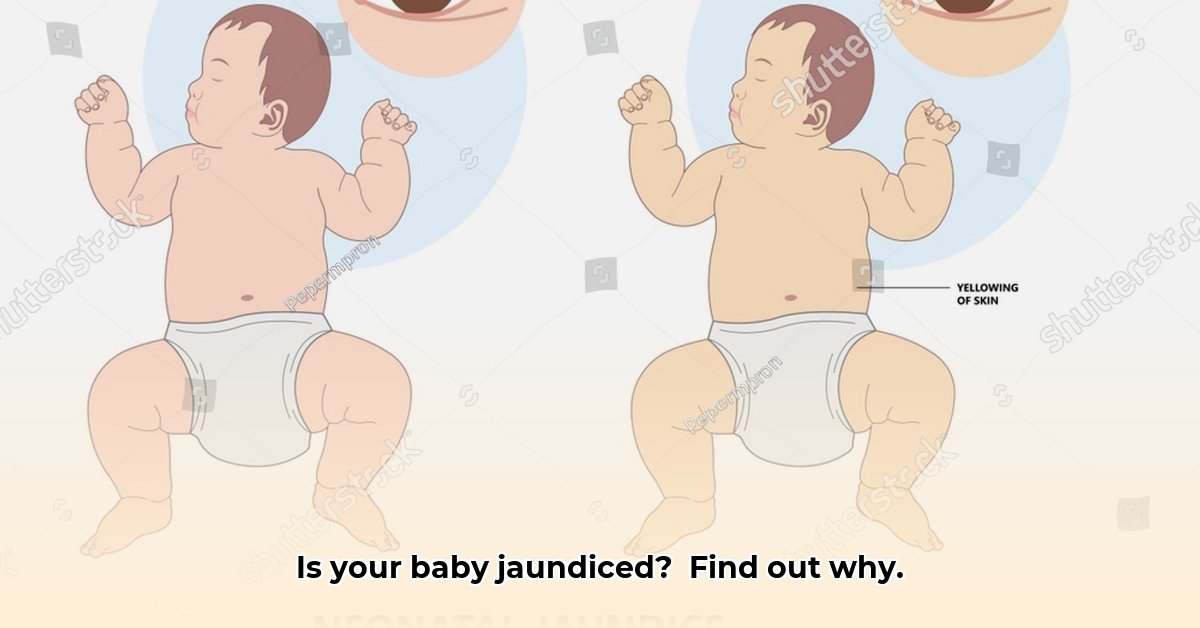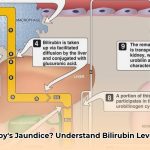Jaundice, characterized by the yellowing of a baby’s skin and eyes, is a common concern for new parents. Early detection and appropriate care are paramount to ensuring your baby’s well-being. This guide provides essential information on recognizing jaundice, understanding potential risks, and accessing necessary treatment. For accurate bilirubin level testing, consider using resources like newborn bilirubin tests.
Understanding Neonatal Jaundice
Neonatal jaundice arises from an elevated level of bilirubin in the blood—a natural byproduct of red blood cell breakdown. While often a normal physiological process as the newborn’s liver matures, high bilirubin concentrations can be harmful. Early assessment is essential to differentiate between benign jaundice and cases requiring medical intervention, thereby optimizing outcomes for your baby.
Identifying Jaundice: A Step-by-Step Visual Guide
The initial step in assessing jaundice involves careful visual examination under good lighting:
- Press Gently: Gently press on your baby’s skin (forehead or nose).
- Observe Color: A yellowish discoloration remaining after releasing pressure indicates potential jaundice.
- Check Key Areas: Observe the face, chest, arms, and legs for yellowing.
Detecting jaundice can be challenging in babies with darker skin tones. In these cases, focus on:
- Gums: Examine the gums for yellowness.
- Eyes: Check the whites of the eyes (sclera) for any yellowing.
When in doubt, consult your doctor for a professional assessment.
Accurate Bilirubin Testing Methods
Visual assessment is subjective and should be followed by objective bilirubin testing:
- Total Serum Bilirubin (TSB): A blood test providing a precise measurement of bilirubin levels. This is the gold standard for diagnosis.
- Transcutaneous Bilirubin (TcB): A non-invasive method using a device to measure bilirubin through the skin. TcB is useful as a screening tool, especially for babies with darker complexions, where visual assessment is less reliable. However, TcB measurements should be confirmed with TSB if the levels are high or if there are concerns about accuracy.
These tests quantitatively determine the severity of jaundice and guide treatment decisions made by a pediatrician.
Risk Factors to Consider
Certain factors increase a baby’s risk of developing significant jaundice:
- Prematurity: Premature infants often have liver immaturity, increasing susceptibility to bilirubin buildup.
- Feeding Difficulties: Poor feeding can lead to dehydration and decreased bowel movements, impairing bilirubin elimination.
- Family History: A family history of jaundice elevates the risk due to genetic predispositions.
- Blood Type Incompatibility: ABO or Rh incompatibility between mother and baby can lead to increased red blood cell breakdown and, consequently, higher bilirubin levels.
- Bruising at Birth: Significant bruising can result in increased bilirubin production as the body breaks down the extra blood cells.
- East Asian or Mediterranean Descent: Babies of East Asian or Mediterranean descent have a statistically higher likelihood of developing jaundice.
- Glucose-6-Phosphate Dehydrogenase (G6PD) Deficiency: Babies with G6PD deficiency are more prone to jaundice.
Identifying risk factors allows healthcare providers to implement targeted monitoring and intervention strategies.
Treatment Options for Elevated Bilirubin Levels
Treatment strategies depend on bilirubin levels, the baby’s age, overall health, and any underlying conditions.
- Enhanced Feeding: Frequent breastfeeding (8-12 times per day) or formula feeding promotes bowel movements and bilirubin elimination. If breastfeeding is challenging, consult a lactation consultant. Supplementation with formula may be recommended in some cases.
- Phototherapy: Exposure to special blue lights helps break down bilirubin into a form that can be easily excreted in urine and stool. Phototherapy can be administered in the hospital or at home with appropriate monitoring.
- Intravenous Immunoglobulin (IVIg): In cases of jaundice due to blood type incompatibility, IVIg may be used to reduce the breakdown of red blood cells.
- Exchange Transfusion: In rare, severe cases, an exchange transfusion is performed. This involves replacing the baby’s blood with donor blood to rapidly lower bilirubin levels and prevent brain damage. This procedure is performed in a newborn intensive care unit (NICU).
Here’s a quick reference table for jaundice treatment options:
| Treatment Option | Description | Potential Side Effects |
|---|---|---|
| Enhanced Feeding | Frequent breastfeeding or formula feeding to promote bowel movements and bilirubin excretion. | Generally none; may prevent the need for further treatments. |
| Phototherapy | Exposure to special blue lights, which alter bilirubin molecules in the skin, allowing them to be excreted more easily. | Loose stools, temporary skin rash, dehydration. |
| Intravenous Immunoglobulin (IVIg) | Infusion of antibodies to reduce red blood cell breakdown in cases of blood type incompatibility. | Rare allergic reactions. |
| Exchange Transfusion | Replacement of the baby’s blood with donor blood to rapidly lower bilirubin levels; reserved for severe cases when other treatments are not effective. | Potential risks include bleeding and infection; undertaken only in critical cases of extremely high bilirubin. |
Recognizing When to Seek Immediate Medical Attention
Seek immediate medical attention if your baby exhibits:
- Lethargy or Unresponsiveness: Excessive sleepiness or difficulty waking.
- High-Pitched Cry: An unusual or concerning cry.
- Difficulty Feeding or Poor Suckling: Refusal to feed or inability to latch properly.
- Rapidly Worsening Jaundice: Yellowing that spreads quickly or becomes more intense.
- Yellowing Below the Waist: Jaundice extending to the abdomen or legs.
- Fever: A temperature of 100.4°F (38°C) or higher.
- Arching of the Back: Stiffness or arching of the neck and back.
These symptoms indicate potentially dangerous bilirubin levels requiring prompt medical intervention.
Follow-Up Care and Monitoring
Regular check-ups after treatment are essential to monitor bilirubin levels and ensure they are declining appropriately. Your pediatrician will determine the frequency of follow-up appointments based on your baby’s individual needs.
Understanding Transcutaneous Bilirubinometry in Dark-Skinned Newborns
Transcutaneous bilirubin (TcB) readings can underestimate true bilirubin levels in dark-skinned newborns, especially at higher bilirubin concentrations. Therefore, accurate jaundice assessment necessitates careful consideration of skin tone and, when necessary, confirmation with a TSB test for reliable results.
Preventing Kernicterus: A Focus on Early Intervention
Kernicterus is a rare but serious complication of severe jaundice that can cause permanent brain damage. High unconjugated bilirubin levels can cross the blood-brain barrier and damage the brain and nervous system.
The key to preventing kernicterus is early detection through visual assessment and bilirubin testing, followed by prompt and appropriate treatment. Consistent monitoring is crucial to prevent lasting harm.
Managing Neonatal Jaundice in Resource-Limited Settings
Neonatal jaundice management in resource-limited settings faces unique challenges, including limited access to diagnostic tools and treatment options.
Strategies for improving care in these settings include:
- Improved Visual Assessment Training: Training healthcare providers to accurately assess jaundice visually, even in babies with darker skin tones.
- Point-of-Care Testing: Utilizing portable, affordable bilirubin testing devices.
- Task Shifting: Training community health workers to identify and refer jaundiced newborns.
- Phototherapy Devices: Innovative and affordable phototherapy devices designed for low-resource settings.
Collaboration and investment are essential to developing sustainable solutions for managing neonatal jaundice in these settings.
- Vertical Axis Wind Turbine Design: Improving Efficiency and Overcoming Limits - October 29, 2025
- Wind Turbine to Power Home: Nacelle Design Improvements Advance - October 26, 2025
- Wind Turbine Blade Length: How Long Is Too Long? - October 24, 2025
















